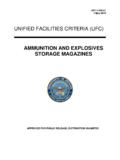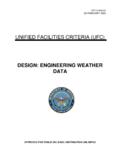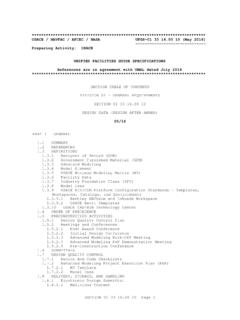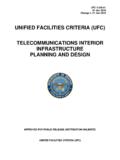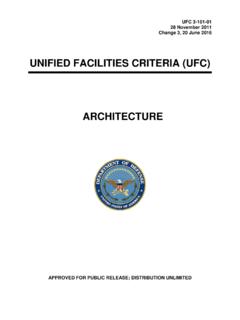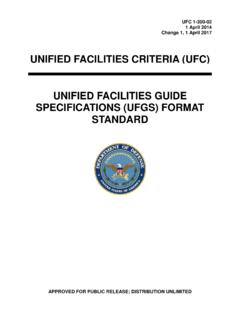Transcription of MO-201 Electric Power Distribution Systems
1 Naval Facilities Engineering Command 200 Stovall Street Alexandria, Virginia 22332-2300 Electric Power Distribution Systems Operations NAVFAC MO-201 April 1990SN 0525-LP-320-1900 FOREWORD This manual on Electric Power Distribution Systems is one of a series developed to aid utilitysupervisory personnel at shore establishments in the performance of their duties. It includesinformation obtained from extensive research of current literature on the subject and preferredpractices based on practical experience.
2 The principles and procedures described are inaccordance with national professional society, association, and institute codes. Additional information concerning procedures, suggestions, recommendations ormodifications that will improve this manual are invited and should be submitted throughappropriate channels to the Commander, Naval Facilities Engineering Command, (Attention: Code 165), 200 Stovall Street, Alexandria, VA 22332-2300. This publication has been reviewed and approved in accordance with the Secretary of theNavy Instruction and is certified as an official publication of the Naval FacilitiesEngineering Command. It cancels and supersedes Operation of Electric Power DistributionSystems, NAVFAC MO-201 , November 1963, in its entirety.
3 D. B. CAMPBELL Assistant Commander for Public Works Centers and Departmentsi PAGE ii INTENTIONALLY LEFT BLANK ABSTRACT Application principles and procedures for the operation of Electric Power Distribution systemsand associated major apparatus are presented. The contents include principles of Power Systems ,cabling Systems , electrical equipment, Power system protection and coordination, instrumentsand meters, operational procedures, and electrical utilization Systems . iii PAGE iv INTENTIONALLY LEFT BLANKCHANGE CONTROL SHEETD ocument all changes, page replacements, and pen and ink alterations posted in this DATEPOSTED BY(LAST NAME)
4 V PAGE vi INTENTIONALLY LEFT BLANK CONTENTS PAGE CHAPTER 1 PRINCIPLES OF Power Systems 1-1 Typical Power 1-1 Electric Power 1-2 Alternating Current Power Transmission 1-3 Primary Distribution 1-4 Secondary Distribution 1-9 Emergency and Standby Power 1-15 CHAPTER 2 Power Distribution CABLE Systems 2-1 Cable 2-1 Cable 2-1 Cable Ratings and Selection 2-5 Types of Cable 2-7 Power system 2-10 CHAPTER 3 Power system ELECTRICAL EQUIPMENT 3-1 Major 3-1 3-2 Voltage 3-16 3-21 Circuit 3-26 Automatic Circuit 3-38 Power 3-44 Distribution 3-53 CHAPTER 4 Power system PROTECTION AND COORDINATION 4-1 system Protection 4-1 Short-Circuit 4-2 4-8 Applied Protective 4-15 4-19 Low-Voltage Circuit 4-25 system Coordination 4-28 CHAPTER 5 Power system INSTRUMENTS AND METERS 5-1 Instrumentation and 5-1
5 5-3 5-6viiCONTENTS (continued) PAGE CHAPTER 6 Power system OPERATION 6-1 Power system 6-1 Control Center 6-2 6-5 Safety and Environmental 6-8 CHAPTER 7 ELECTRICAL UTILIZATION Systems 7-1 system 7-1 Equipment Nameplate Ratings and Nominal system 7-1 Street Lighting 7-3 CHAPTER 8 MANAGING THE OPERATION OF ELECTRICAL Distribution Systems 8-1 Operations 8-1 Operations 8-1
6 Maintenance 8-9 system Planning 8-14 CHAPTER 9 NEW AND EMERGING TECHNOLOGY 9-1 Supervisory Control and Data 9-1 Control Circuits and 9-4 9-6 Variable Speed Electric Drive 9-7 APPENDIX A Operating Responsibilities and Organizational A-1 Bibliography-1 Index-1 viii FIGURESFIGURE NO. TITLE PAGE1-1 Typical Electric Power Generation, Transmission, and Distribution 1-11-2 Typical Distribution Substation 1-51-3 Typical Bus 1-71-4 Four Primary Feeder 1-81-5 Conventional Simple-Radial Distribution 1-111-6 Expanded Radial Distribution 1-111-7 Primary Selective Distribution 1-121-8 Loop Primary-Radial Distribution 1-121-9 Secondary Selective-Radial Distribution 1-141-10 Secondary Network Distribution 1-141-11 Secondary Banking Distribution 1-161-12 Engine Generators (Parallel Operation).
7 1-201-13 Peak Load Control 1-201-14 Combined Utility-Generator 1-201-15 Rotating Flywheel No Break 1-241-16 Nonredundant UPS 1-251-17 Nonredundant UPS system with Static 1-251-18 Redundant UPS 1-263-1 3-83-2 3-83-3 3-93-4 3-93-5 3-103-6 3-103-7 Scott Connection (Three-Phase to Two-Phase Transformations).. 3-113-8 Six-Phase Star (Three-Phase Delta to Six-Phase Star Connection).. 3-113-9 Zigzag Three-Phase Grounding 3-153-10 Bypass Switching Arrangement for Single-Phase Voltage 3-203-11 Three-Phase Vacuum Loadbreak Switch (Reproduced Courtesy of McGraw-Edison Company).. 3-243-12 Circuit Breaker Arc Chute Interruption.
8 (Reproduced Courtesy of Westinghouse Electric Corporation).. 3-283-13 Padmounted Vacuum Circuit Breaker (Reproduced Courtesy of McGraw-Edison Company).. 3-303-14 Low-Voltage Metal-Enclosed Air Circuit Breaker Switchgear (Reproduced Courtesy of Westinghouse Electric Corporation).. 3-32ix FIGURES (continued)FIGURE NO. TITLE PAGE3-15 Automatic Oil Circuit Reclosers (Reproduced Courtesy of McGraw-Edison Company).. 3-403-16 Typical Single-Phase Automatic Recloser Construction (Reproduced Courtesy of McGraw-Edison Company).. 3-413-17 Pole Mounted Capacitor (Reproduced Courtesy of McGraw-Edison Company).
9 3-463-18 Metal-Enclosed Capacitor Bank (Reproduced Courtesy of McGraw-Edison Company).. 3-473-19 Open-Rack Capacitor Installation (Reproduced Courtesy of McGraw-Edison Company).. 3-484-1 Symmetrical Short-Circuit Current 4-54-2 Decreasing Symmetrical Short-Circuit 4-64-3 Asymmetrical Short-Circuit Current 4-74-4 A Typical Power system and Its Zones of 4-164-5 Open Fuse Cutout (Reproduced Courtesy of McGraw-Edison Company).. 4-234-6 Open-Link Cutout (Reproduced Courtesy of McGraw-Edison Company).. 4-244-7 Time-Current Curve 4-328-1 system 8-18 TABLESTABLE NO. TITLE PAGE3-1 Troubleshooting Chart for Circuit Breaker 3-363-2 Overvoltage 3-523-3 Expected Soil 3-544-1 Relays Generally Used for Motor 4-19 ACKNOWLEDGEMENTSAll photographs were provided, without charge, courtesy of the Power system Group,McGraw-Edison Company, Pittsburgh, PA and Westinghouse Electric Corporation,Pittsburgh, 1.
10 PRINCIPLES OF Power TYPICAL Power NETWORK. An understanding of basic design principles is essential inthe operation of Electric Power Systems . This chapter briefly describes and defines Electric powergeneration, transmission, and Distribution Systems (primary and secondary). A discussion ofemergency and standby Power Systems is also presented. Figure 1-1 shows a one-line diagramof a typical electrical Power generation, transmission, and Distribution Electric Power GENERATION. A generator is a machine that transforms mechanicalenergy into Electric Power . Prime movers such as engines and turbines convert thermal orhydraulic energy into mechanical Power . Thermal energy is derived from the fission of nuclearfuel or the burning of common fuels such as oil, gas, or coal.
